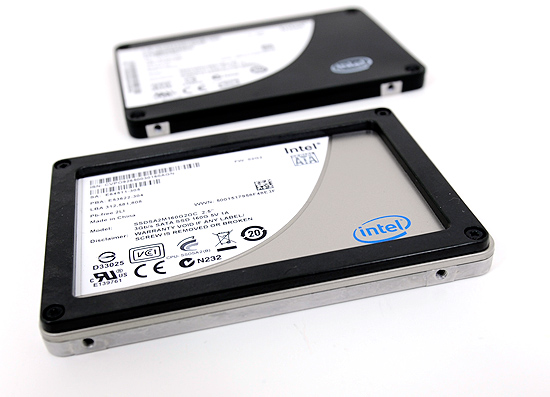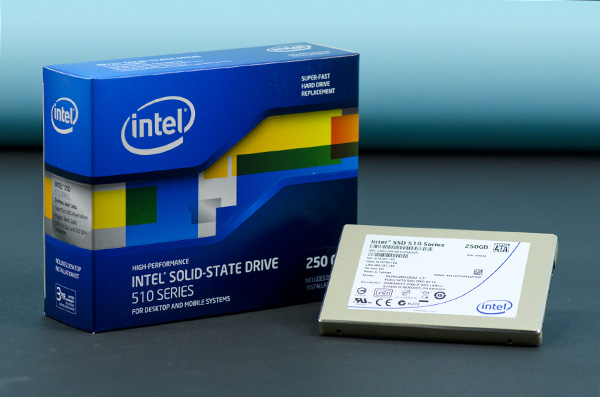The Intel SSD 510 Review
by Anand Lal Shimpi on March 2, 2011 1:23 AM EST- Posted in
- IT Computing
- Storage
- SSDs
- Intel
- Intel SSD 510
The X25-M was a tremendous first attempt by Intel to get into the SSD market. In our review of the SSD I wrote that Intel just Conroe’d the SSD market, and if it weren’t for the pesky 80MB/s sequential write speed limitation the X25-M would’ve been given the title: World’s Fastest Drive.

Its successor, the X25-M G2, was a mild update that brought prices down through the use of 34nm NAND. Remember that Intel is also 49% owner of the IMFT joint venture and as a result can be quite competitive on NAND pricing (and quite early to adopt new NAND technologies).

Intel’s goal all along was to drive down the cost of SSDs. Looking at the history of MSRPs with the X25-M (not to mention the M, which stood for Mainstream in the product name) this shouldn’t come as a surprise:
| Intel X25-M Pricing History | |||||
| 2008 | 2009 | ||||
| 40GB | - | $125 | |||
| 80GB | $595 | $225 | |||
| 160GB | $1000+ | $440 | |||
The third generation X25-M was to drive down costs even further, this time thanks to Intel’s 25nm NAND. You’d be able to get twice the capacity at the same price point as the X25-M G2. The value drive would be an 80GB offering, the mainstream drive would be 160GB and the high end drive would be 320GB.
The drive would offer higher performance. The controller was to be completely redesigned, with the “oversight” that limited sequential write speed to only 100MB/s corrected entirely. In addition, the third generation Intel SSD would add full disk encryption - making it even better suited for enterprise customers. Going after the enterprise market was Intel’s plan to really make money on SSDs in the long run. Instead of just selling corporations a CPU, chipset and wireless controller in a notebook, there would be an SSD on top of all of that. Perhaps eventually even have some security software courtesy of McAfee.
The third generation X25-M was originally due out in the middle of 2010. As is usually the case with schedules, the “G3” slipped. The middle of the year became the end of the year and the end of the year became Q1 2011.
To make matters worse, the specifications Intel was talking about for its third generation drive/controller weren’t all that competitive. We published the details last year knowing that the competition would do better. Intel’s redesigned controller was late and underperforming. Internally, Intel knew it had a problem.
Intel aimed for the majority of the market with the X25-M, it had set its sights on lowering cost, but it left the high performance enthusiast market entirely uncared for. A void that SandForce filled quite nicely with its unique brand of controllers.
With a hole in the roadmap and an unwillingness to cede complete control of the high end market to SandForce, Intel did the unthinkable: developed a new SSD based on a competing controller technology.











128 Comments
View All Comments
deadsmeat - Wednesday, March 2, 2011 - link
I am not sure if I missed it, but will you do a price/performance for SSDs? For example, and Intel or Corsair SSD migth be the fastest, but if it has a good price/performance vs the fastest SSD then it's something that consumers might consider when getting an SSD.I don't have a clear "performance" since you have run many benchmark in there, but something like a "real world load" would be good to see. I may not want the fastest SSD, but I will be looking for something that has good over-all balance in performance, and not so heavy on the pocket...
deadsmeat - Wednesday, March 2, 2011 - link
Woops, I missed "not" i.e.Intel or Corsair SSD might NOT be the fastest, but if it has a good price/performance vs the fastest SSD then it's something that consumers might consider when getting an SSD.
dagamer34 - Wednesday, March 2, 2011 - link
I thought that's what the light benchmark was, more "normal" tasks that aren't super-abusive with the SSD.vol7ron - Wednesday, March 2, 2011 - link
Yes, light being "AnandTech Storage Bench 2011 - Light Workload".Either Light or Heavy depending on your use seems to be a combination of both random and sequential performance.
As stated in the article:
"I'll be sharing the full details of the benchmark in some upcoming SSD articles but here are some details:
1) The MOASB, officially called AnandTech Storage Bench 2011 - Heavy Workload, mainly focuses on the times when your I/O activity is the highest. There is a lot of downloading and application installing that happens during the course of this test. My thinking was that it's during application installs, file copies, downloading and multitasking with all of this that you can really notice performance differences between drives.
2) I tried to cover as many bases as possible with the software I incorporated into this test. There's a lot of photo editing in Photoshop, HTML editing in Dreamweaver, web browsing, game playing/level loading (Starcraft II & WoW are both a part of the test) as well as general use stuff (application installing, virus scanning). I included a large amount of email downloading, document creation and editing as well. To top it all off I even use Visual Studio 2008 to build Chromium during the test."
therealnickdanger - Wednesday, March 2, 2011 - link
What price would you use? MSRP? Newegg after MIR? Just pick a usage scenario that fits your usage and divide the score by the dollar amount of your favorite e-tailer... Pretty simple.vol7ron - Wednesday, March 2, 2011 - link
Why not have both? AT has used a price grabber in the past.Actually, where did that go? It started to break down on the old site, but I'd like to see AT put that part shopper back up.
MrDiSante - Wednesday, March 2, 2011 - link
Realistically speaking, if you're buying computer components/peripherals, the functionRetailer GetLowestPrice(Component component)
{
return Newegg;
}
would probably be better than the average price comparison site.
marraco - Wednesday, March 2, 2011 - link
To be useful, the comparison needs to consider RAID 0 setups.dagamer34 - Wednesday, March 2, 2011 - link
It seems like the one true major difference between the Intel SSD 510 and the OCZ Vertex 3 is that one is available now while the other is only talked about in reviews. First to market is always a benefit for a manufacturer that has a decently performing product, though Newegg's markup makes early adopter's pay dearly for it.Of course, this leads to the important question of "when will the Vertex 3 series reach general availability?" I recently purchased a 120GB OCZ Vertex 2 for a new 2011 17" MacBook Pro and the performance is stunning compared to the stock HDD (it's my first SSD). I'm wondering if I should return the drive and just wait for the Vertex 3 because once you've gone SSD, it is so hard to go back!
Thanks for the review Anand!
dagamer34 - Wednesday, March 2, 2011 - link
Oh, another thing. Are we going to get an SSD State of the Union for 2011? I'm guessing you're waiting to finish the reviews of most of the SSDs that are coming out this year first... Yeah, I just answered my own question, I think. :)